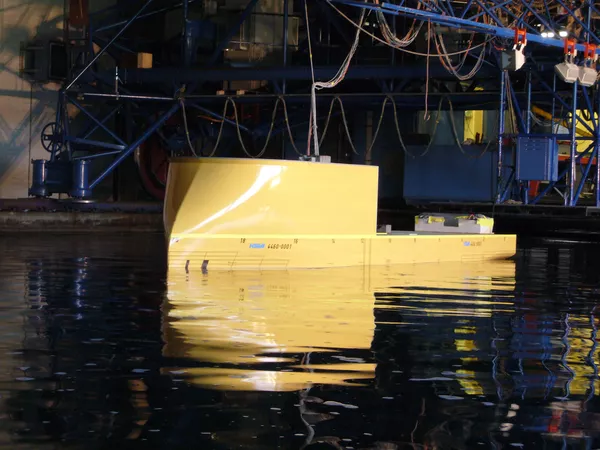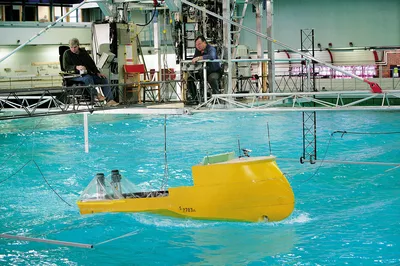
Tank test and real-life comparison
When new hull designs are undergoing tank tests, a scale model must endure various waves and wave length conditions. We have performed model tests and comparative model tests for X-BOW hulls and bulbous bows in areas such as supply, seismic, offshore construction, drill, short-sea and anchor handling tug supply.
The video below compares the X-BOW hull (left) and bulbous bow (right) in the same conditions.
The following list of results is a summary of the model tests carried out on offshore vessels. The tests have been performed at model testing facilities in several countries.
Calm water
- Waterline lengthening bulb included in bow shape
- Lower angles of entry
- Allows large draught variations as compared to gooseneck bulbous bows
- Improved initial stability
Waves
- No slamming loads – less vibrations
- Less pitching due to earlier volume introduction in waves
- Waterlines extending to full hull height will split wave energy rather than crush the waves and create spray
- Lower acceleration levels
- Lower pitch response due to volume is not translated into loss of speed
- Lower speed loss – this effect increases with increasing wave height
- Gentle displacer
Heave
- In all conditions, the heave motions are comparable for both bow shapes.
Roll
- Relatively small roll motions due to the high natural roll period of the vessel design. For bow quartering seas, the roll of the X‐BOW is favourable compared to the conventional bow.
Pitch
- The pitch motions are similar for both bow shapes. In higher waves, the pitch motions for the conventional bow became higher.
Wavedrift
- Wavedrift forces at zero speed are of interest for the dynamic positioning of the vessel. The lower the forces the better the DP performance or equally lower fuel consumption and emissions.
Bow impact pressures
- The bow impact pressures were measured at several heights along the bow, and showed large differences.
Acceleration levels
- The longitudinal acceleration levels are considerably lower for the X‐bow. The explanation for this can only be found in the bow shape, giving less wave impact. The transverse accelerations are also lower for bow quartering sea states. The lower acceleration levels in the horizontal plane, lead to a higher comfort level on board. The accelerations in the vertical direction are equal.
Stability characteristics
- A bulbous bow displaces more volume below the waterline at the bow, which as a consequence results in less area at the waterline.
- The X‐bow features a specific volume distribution over the depth of the hull and the superstructures which leads to a fuller waterline at the bow.
- This difference results in a better initial stability of the X‐bow compared to the conventional bow.
- As a result of the higher initial stability the deck load capacity (or allowable VCG) is higher on the X‐bow.
Conclusions from model testing offshore vessels
- The X‐BOW has benefits over a conventional, bulbous bow, especially where it concerns comfort.
- This is due to the fact that there is no bow impact in terms of slamming, acceleration levels are lower.
- Also vibration levels will be lower and the sustained speed is higher, but more importantly the short duration of speed loss due to bow wave impact is not there. This gives high level of confidence to the captain to sail at higher speeds where a captain on a vessel with a conventional bow would reduce speed.
- Regarding stability characteristics the X‐BOW is also beneficial.
Are there operational areas where the X-BOW would be especially beneficial?
- The results from the model tests conclude that for severe sea states the advantage of the ULSTEIN X‐BOW® over a conventional bulbous bow increases, this means that for harsh environments the ULSTEIN X‐BOW® is the shape of choice.
- Spray water at the bow is minimized. This, together with the enclosed nature of the bow area makes the X‐BOW very suited for Arctic conditions.

The final test comes when the completed vessel enters into open seas
The real-life comparison below shows 'Skandi Caledonia' and 'Bourbon Orca' (the first X-BOW® vessel) on their way from Mongstad to the North Sea on 16 January 2007. 'Skandi Caledonia' has a speed of 8 knots, while 'Bourbon Orca' is keeping a speed of 13 knots.